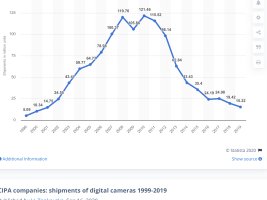This graph from CIPA showing camera ‘out the door’ volume that actually covers the last 20 years aptly demonstrates my point of the market returning to historical norms. In 1999 the camera market (not including phones) was 5.09 million units, in 2019 it was 15.22 million units, three times the number of 20 years ago. The camera market is not in trouble, it is no longer enjoying the boom period from 2002 -2016, but it is far from in trouble.
View attachment 194735
World population
Smartphone initial release
2019 Worldwide shipments
Yup... smartphones did
not impact sales of digital still cameras (DSC). /s
Your graph's upward ascent paused in 2008, dipped in 2009 and bounced back in 2010.
2011-onwards it nose dived.
2017 was the year that more than 1 rear cameras with a wide, standard or tele lens started becoming the norm.
Would not be surprised if ultra wide, wide, standard, tele and super tele lenses would come out within the next 5 years.
Thus negating super zooms and ultra wide point & shoots.
For 2020 I would be very surprised
if shipments breached 9 million DSC relative to 2019's 15.22 million.
10 out of 12 months of 2020 had less than 7 million DSC shipped globally. Assuming a very optimistic 80% of Nov-Dec 2019 DSC shipped in the last 2 months of 2020 would only be less than 2 million.
Will 2030 have the DSC back to shipping 5 million SDC like in 1999? Smartphones had zero involvement!
Be aware that sales people tend to encourage dealers to order more than they could possibly sell. Manufacturers may tolerate delayed accounts receivables from their dealers. Would not be surprised if dealers have more than normal number of inventory on hand with the option to return with little to no penalty. Manufacturers have an incentive to tolerate to do a bit of window dressing for end of year.
So shipments is not that good an indicator. Would be better to show settled accounts receivable.
Point & shoots dried up and went premium with larger image sensors than an smartphone or specialized with super zooms and underwater features. Would not be surprised that point & shoot numbers for 2019 is about 20% of what it was at its peak.
ILCs like SLRs and mirrorless are somewhat less impacted but outside of (a) working photographers, (b) first time ILC buyers that have at most 2 lenses and (c) well funded pensioners no one is upgrading to every new Mark 2, 3 or 4 upgrade. People tend to keep their cameras until they fall apart then evaluate if they should buy a camera that's bigger than their smartphone. Would not be surprised that point & shoot numbers for 2019 is about 20% of what it was at its peak.
1 out of 3 users has their carrier's "push" upgrades to them when their contract
ends in 2-3 years. So people get a new "camera" every 2-3 years. Every new replacement smartphone has a better camera which does not need a PC to get involved to download, post process and share.
If my carrier allowed me to buy a R5 on a 2 year contract I'd probably go for one at $162.50/month + $11/month service.
So did smartphone put an end on the bull run of worldwide shipments of cameras? Probably
not. /s
Best camera you can ever own is the one with you always. For the past decade it was either a iPhone or Android.


